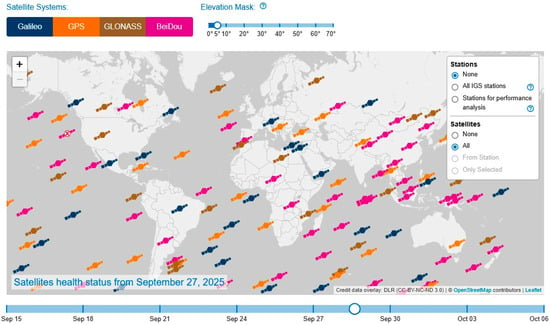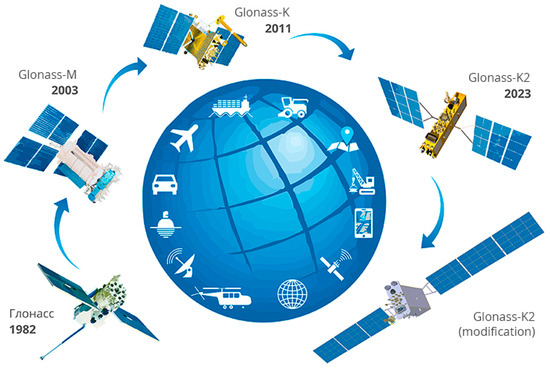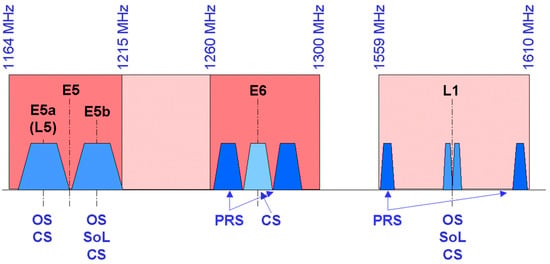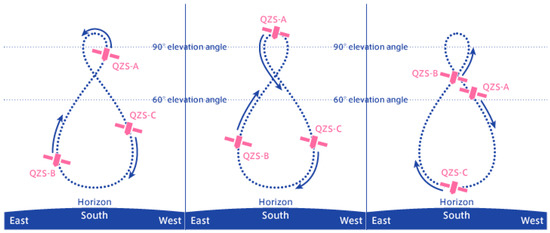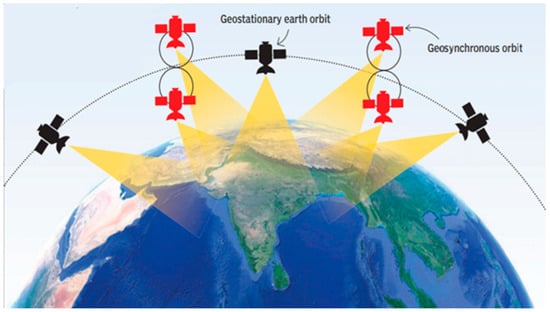Abstract
This review provides an extensive overview of the modernization of Global Navigation Satellite System (GNSS), Regional Navigation Satellite System (RNSS), and Satellite-Based Augmentation System (SBAS) up to 28 September 2025. It covers a description of the individual systems, the new launched satellites, and the new civil signals. GNSS includes the United States’ GPS, Russia’s GLONASS, the European Union’s Galileo, and China’s BDS. In the last several years there has been an intensive development of RNSS, which primarily encompass the Japan’s QZSS, India’s IRNSS, and the South Korea’s KPS. The focus of this research is analyzing the possibilities of advancing Position, Navigation, and Timing (PNT) service as well as future perspective and trends in the field of satellite positioning and navigation. SBAS supports satellite systems by providing civil aviation users with corrections and integrity information. Additional to WAAS and EGNOS, this paper examines several more SBAS currently under development. Furthermore, it provides a concise overview and discussion of the above systems, as well as innovations in space technology in the Republic of Croatia. In addition, it emphasizes the influence of political events on the development of satellite systems as well as the role of aerospace companies.
1. Introduction
The Global Navigation Satellite System (GNSS) is the foundation of modern technology, enabling accurate determination of Position, Navigation, and Timing (PNT) in real time or through post-processing. GNSS includes the United States’ Global Positioning System (GPS), Russia’s Global Navigation Satellite System (GLONASS—Global NAvigatsionnaya Sputnikovaya Sistema), the European Union’s Global Navigation Satellite System (Galileo), and China’s Beidou Navigation Satellite System (BDS). The development of these systems represents a significant technological advancement in the field of military, geolocation, with wide-ranging applications in transportation, agriculture, construction, operations, and everyday use by mobile device users.
The GPS project was initiated by the U.S. Department of Defense in 1973, aiming to develop a reliable navigation system. The first Block I series was launched in 1978, marking the beginning of in-orbit testing and validation. After the launch of 24 satellites, GPS achieved Full Operational Capability (FOC) in 1993, and it became the first functional navigation system [1,2].
GLONASS was initially developed in 1982, achieving its FOC in 1996. However, due to the short lifespan of its satellites, the system was not operational for an extended period. It eventually regained FOC in 2021 with a complete constellation of 24 satellites [3].
Development of Galileo and BDS began in the late 1990s. In contrast to the earlier GPS and GLONASS, Galileo and BDS have been designed with more modern and advanced technologies. This modernization allowed them to offer enhanced features such as improved signal accuracy, greater resistance to interference, and expanded global coverage. These systems support interoperability with existing global navigation satellite systems, enabling more reliable and robust positioning and timing services. They represent a significant advancement in PNT, offering increased precision and a wider range of applications in both military and civilian domains [4,5].
Regional Navigation Satellite System (RNSS) is a satellite-based positioning system designed to provide precise positioning, navigation, and timing services over specific geographic areas. RNSS typically feature constellations of satellites optimized to serve a particular region or continent, offering tailored coverage that meets local requirements for accuracy, availability, and reliability. The development of RNSS reflects the growing demand for enhanced PNT capabilities in areas where global systems may face limitations due to signal obstruction, interference, or other environmental and geopolitical factors. RNSS includes the Quasi-Zenith Satellite System (QZSS) developed by Japan, the Indian Regional Navigation Satellite System (IRNSS), also known as NavIC, and the Korean Positioning System (KPS) developed by South Korea.
Table 1 shows the GNSS and RNSS analyzed in this paper, naming the first and last launches of satellites up to 28 September 2025.

Table 1.
Launch history of Global Navigation Satellite System (GNSS) and Regional Navigation Satellite System (RNSS) [1,2,5,6,7,8,9].
Satellite-Based Augmentation System (SBAS) is regional system designed to enhance the performance of GNSS. SBAS significantly improves the accuracy, integrity, continuity, and availability of GNSS signals, enabling PNT services with higher accuracy than GNSS. They are especially important in aviation, where they support the most critical phases of flight, such as landings. To ensure a high level of safety and reliability, SBAS must comply with strict operational requirements set by the International Civil Aviation Organization (ICAO) [10,11]. This paper provides a review of nine SBASs that are currently operational or racing development.
GNSS satellites are most often located in Medium Earth Orbit (MEO), which provides optimal coverage and signal persistence. RNSSs may use different orbits: Low Earth Orbit (LEO), MEO, or Inclined Geosynchronous Orbit (IGSO) to adapt to specific regional needs.
Following an extensive review of modernization of GNSS, RNSS, and SBAS, the Discussion section offers a summary of these systems along with recent developments in space technologies, including the impact of Starlink, the United Kingdom’s post-Brexit, and innovations in Republic of Croatia.
4. Satellite-Based Augmentation System (SBAS)
Satellite-Based Augmentation System (SBAS) is regional system designed to enhance the performance of GNSS, particularly in terms of accuracy, integrity, continuity, and availability. They achieve this by broadcasting correction and integrity data through geostationary satellites to users within their service regions. SBASs are especially critical for safety-critical applications such as civil aviation, but also support a wide range of other domains including agriculture, transportation, and disaster management [35]. ICAO Annex 10 sets strict requirements for the accuracy and integrity of radionavigation and communication systems in air traffic to ensure flight safety. The accuracy of systems such as GNSS, the Instrument Landing System (ILS), and the VHF Omnidirectional Range (VOR) must fall within defined limits. GNSS systems achieve horizontal accuracy within 1 m to 3 m, while ILS systems provide accuracy of approximately 5 m in the final approach area. System integrity refers to the ability to promptly detect and report faults, with maximum fault detection times often under 6 s for GNSS. These specifications enable pilots and air traffic controllers to rely on precise and dependable information, thereby reducing the risk of unsafe situations during navigation and flight management [36]. Below is an overview of the major SBASs currently in operation, development, or planning (Table 3).

Table 3.
Satellite-Based Augmentation System (SBAS).
According to available information, currently there are six operational SBASs. Figure 6 shows coverage area of each SBAS, regardless of its status. Present state of SBAS does not include territories of South America, Greenland and northern parts of Canada, and some regions of Africa, as well as Indonesian Archipelago.
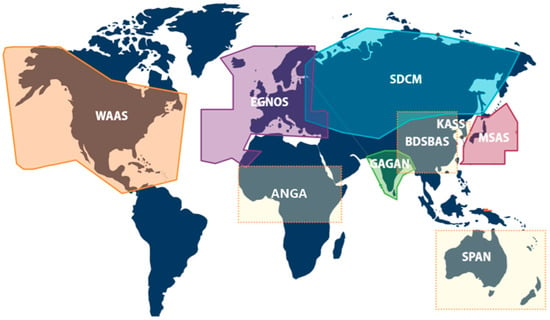
Figure 6.
Coverage areas of all nine Satellite-Based Augmentation Systems (SBASs) (Copyright © 2025 SatNav-Africa Joint Programme Office) [35].
4.1. WAAS
The Wide Area Augmentation System (WAAS) is operated by the United States Federal Aviation Administration (FAA). It provides enhanced GNSS services across North America, including the U.S., Canada, and Mexico. Since its launch in 2003, WAAS has primarily supported precision landings in civil aviation. However, WAAS applications extend to smart agriculture, surveying and mapping, transportation and logistics, and emergency services [37]. The WAAS system currently operates using three active geostationary satellites: Eutelsat 117 West B, SES-15, and Galaxy 30. These satellites transmit differential corrections and integrity information for GNSS signals in real time, significantly improving positioning accuracy to better than 2 m [38]. The key advantages of the WAAS includes high accuracy, integrity, availability, and continuity of service, making it especially suitable for aviation applications such as precision approach procedures without the need for additional ground-based navigation aids. In addition to corrections, WAAS satellites additional ranging sources, further enhancing the reliability of GNSS positioning [38].
4.2. SDCM
System for Differential Corrections and Monitoring (SDCM) is developed by the Russian space agency Roscosmos. It’s designed to enhance the performance of GLONASS and GPS signals over Russian territory and surrounding regions. The system currently operates two geostationary satellites that broadcast SBAS correction messages on the L1 frequency, in compliance with ICAO SBAS standards. This enables its use in civil aviation and other high-accuracy applications. SDCM improves positioning accuracy to 1.5 m and provides real-time integrity monitoring. Key benefits include enhanced precision, reliability, and support for safety-critical operations, such as aviation approaches. Although not yet certified for Safety-of-Life operations, SDCM is under continuous development to achieve full compliance with ICAO SARPS requirements [39,40].
4.3. EGNOS
European Geostationary Navigation Overlay Service (EGNOS) managed by the European Union Agency for the Space Programme (EUSPA). EGNOS covers Europe and parts of North Africa and the Middle East. It has been operational since 2009 and is currently evolving into version 3, which will include support for Galileo signals. EGNOS currently operates three geostationary satellites. These satellites broadcast GNSS correction messages and integrity data in real time, enhancing GPS performance for safety critical applications (Figure 7). EGNOS improves horizontal positioning accuracy to below 1–2 m [38] and provides integrity monitoring by detecting and alerting users to GNSS signal. Key benefits of EGNOS include increased accuracy, safety, and service reliability, particularly in civil aviation for precision approach procedures at airports without requiring ground-based navigation infrastructure. EGNOS is also used in agriculture, maritime, surveying, and other domains that benefit from enhanced GNSS precision and reliability [40].
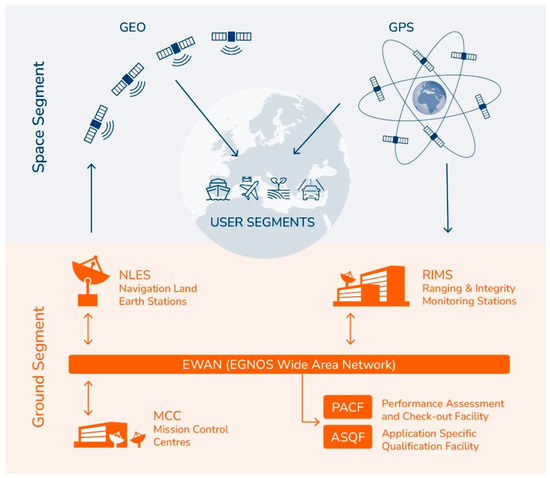
Figure 7.
Infrastructure of European Geostationary Navigation Overlay Service (Copyright © EUSPA 2021–2025) [41].
4.4. BDSBAS
BeiDou Satellite-Based Augmentation System (BDSBAS) is being developed as part of the broader BeiDou Navigation Satellite System. It is intended to serve the Asia-Pacific region to provide high-integrity GNSS augmentation services. BDSBAS is an important part of BDS and will provide the Single Frequency (SF) service through BDSBAS-B1C signal and the Dual-Frequency Multi-Constellation (DFMC) service through BDSBAS-B2a signal for users in China and surrounding areas, in accordance with the ICAO standards. The first BDSBAS satellite was successfully launched in November 2018. The reference coordinate system is WGS84 [42,43].
4.5. MSAS
MTSAT Satellite-Based Augmentation System (MSAS) developed by the Japan Civil Aviation Bureau (JCAB). MSAS is operational since 2007 and provides augmentation services over Japan and parts of East Asia. As of 2023, there is only one QZSS GEO satellite, so MSAS correction information is transmitted from only one GEO satellite, and it is difficult to judge it as fully operational. It is primarily focused on improving aviation navigation services and is fully compatible with GPS, as show in Figure 8 [38].
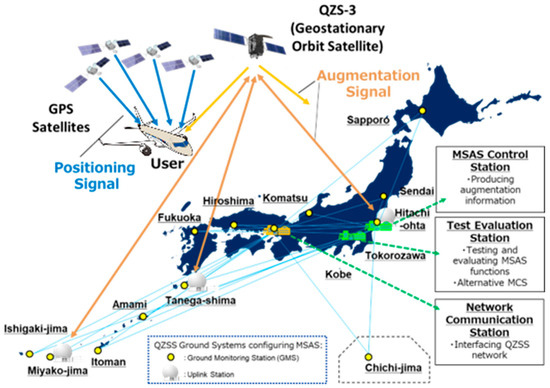
Figure 8.
Configuration of MTSAT Satellite-Based Augmentation System (MSAS) (Copyright © NEC Corporation 1994–2025) [44].
4.6. GAGAN
The Global Positioning System (GPS) Aided Geostationary Earth Orbit (GEO) Augmented Navigation (GAGAN) is a joint initiative by the Indian Space Research Organisation (ISRO) and the Airports Authority of India (AAI). It has been fully operational since 2015. GAGAN broadcasts SBAS navigation data using three GEO satellites on L1 and L5 signals for SBAS data transmission. It enhances GNSS performance over the Indian subcontinent, supporting both aviation and broader regional navigation applications [35,38].
4.7. KASS
The Korean Augmentation Satellite System (KASS) is South Korea’s SBAS developed under the management of Korea Aerospace Research Institute (KARI). The project was launched in 2013. The system uses two geostationary satellites, one of which is active while the other is in development, and it transmits signals on the GPS L1 frequency. The system provides horizontal accuracy of up to 1.5 m [38].
4.8. SouthPAN
Southern Positioning Augmentation Network (SouthPAN) is a collaborative effort between Australia and New Zealand. SouthPAN is being implemented to provide SBAS coverage across Australia, New Zealand, and parts of the South Pacific. Initial services began in 2022, with full aviation-certified service expected by 2028. It will deliver improved accuracy and integrity for diverse applications, including autonomous systems and resource management in addition to provide GPS L1 C/A and L5 signals, and Galileo E1 and E5a signals using PPP services with an accuracy of up to 10 cm [45].
4.9. ANGA
Augmented Navigation for Africa (ANGA) developed by the Agency for the Safety of Air Navigation in Africa and Madagascar (ASECNA), which consists of 18 countries in Africa and the Indian Ocean. It provides autonomous services to users using a technology based on EGNOS. In July of 2021, a successful demonstration of Precise Point Positioning and Early warning services has been conducted. ANGA employs one GEO satellite to broadcast SBAS corrections using the L1 and L5 frequencies. The system is designed to expand to three GEO satellites positioning accuracy to 1 m, with the reference coordinate system is WGS84. It is expected to enhance aviation safety and support broader regional development through improved satellite navigation infrastructure [35,46].
5. Discussion
This review presents an overview of the modernization of GNSS, RNSS, and SBAS, from the first satellite launches to the most recent developments, based on available and recent literature.
GNSS provides global coverage and has a wide range of applications. RNSS focus on specific geographic areas, offering precision and reliability tailored to local needs. SBASs further improve the accuracy, integrity, and availability of GNSS signals, which is essential for the safety of critical applications such as civil aviation and maritime navigation.
GNSS and RNSS form the modern infrastructure of PNT. From global positing and real-time navigation to time synchronization, PNT technologies enable the functioning of key sectors of society and the economy. Key technical elements, such as satellite orbits and the frequency spectrum used to transmit signals, significantly affect the performance and applicability of each system.
The key data in this review are summarized in Table 4. As of 28 September 2025, a total of 117 GNSS and 10 RNSS satellites are operational.

Table 4.
Frequencies and Services of GNSS and RNSS on 28 September 2025 [1,2,3,5,21,22,24,26,31,38].
The accuracy data in Table 4 refers to absolute positioning within a 95% confidence interval under optimal conditions, with good signal reception, open skies, and minimal multipath effects. However, it is important to note that actual accuracy can vary significantly depending on factors such as the use of multi-frequency receivers, satellite geometry, environmental conditions (e.g., urban canyons), and the application of correction systems in positioning methods (RTK or PPP).
Advanced services such as CLAS (QZSS), and HA (KPS) enable high accuracy (at the decimeter level) using additional corrections. In contrast, services like PPS (GPS), HP (GLONASS), PRS and HAS (Galileo), AS (BDS), and RS (IRNSS) are encrypted and intended for authorized users only. The SAR service (Galileo) does not provide a navigation function but enables the location of people in distress, where the accuracy refers to the precision of determining their location, not the position of the user. For relative positioning (using data from multiple receivers and comparing data), accuracy can be much higher, potentially reaching centimeter or even millimeter levels, but this is not the focus of the current analysis.
The L-band (1–2 GHz) and S-band (2–4 GHz) are segments of the radio frequency spectrum used in satellite navigation, each serving distinct roles. The L-band is the primary frequency range for all global GNSSs. These signals offer high reliability, strong atmospheric penetration, and are well-suited for positioning applications in aviation, surveying, autonomous systems, and mobile devices. S-band is not commonly used for basic GNSS signals and is currently only used by IRNSS. It supports higher data rates and increased resilience to certain types of interference, although it has slightly reduced propagation capability through obstacles compared to the L-band. Beyond navigation, the S-band is widely used in radar systems, satellite communications, and telemetry. In summary, the L-band forms the backbone of global satellite navigation, while the S-band serves specific regional and technical functions, particularly in communication and radar domains [47].
5.1. Impact of Brexit—UKSBAS
The United Kingdom’s withdrawal from the European Union (Brexit) had a significant impact on the access of British institutions and users of Galileo and EGNOS. Following Brexit, the UK lost its right to participate in the development of these systems and was excluded from access to security-sensitive services such as the encrypted Public Regulated Service (PRS) signal and the EGNOS Safety-of-Life (SoL) function. Although civilian users in the UK can still access the open service signals of both Galileo and EGNOS, British companies are no longer eligible to compete in EU tenders or contribute to the development of technologies within the European navigation programs. The UK government considered developing its own navigation system. Due to the high estimated cost, the project was eventually abandoned. After that, the UK developed UKSBAS, a satellite-based augmentation system that relies on GPS and covers UK territory, as a temporary substitute for the EGNOS SoL service [48,49].
Situations such as Brexit highlight the strategic importance of GNSS infrastructure and demonstrate how geopolitical decisions can have direct technical and economic consequences for a nation’s navigational autonomy.
5.2. Global Internet Network—Starlink
Starlink is a satellite internet constellation operated by a private aerospace company, SpaceX. It currently has over 8000 active satellites in LEO, arranged in multiple layers at altitudes between 540 km and 570 km. The satellites are divided into orbital groups with different inclinations. The largest number of satellites is concentrated in groups with an inclination of around 53°, enabling global internet access with low latency. SpaceX plans to expand the network to more than 40,000 satellites, which will provide faster internet access but also pose challenges such as space debris and interference with astronomical observations [50,51]. Starlink provides valuable internet access to remote and underserved areas, but a large survey using a prototype of the Square Kilometre Array (SKA-Low) station detected over 112,000 emission events from 1806 unique Starlink satellites. Some of these emissions occurred within frequency bands reserved for radio astronomy (such as 73–74 MHz and 150–153 MHz). These results emphasize that the growing number of satellites poses challenges not only to visual astronomy through reflections and trails, but also to radio astronomy due to electromagnetic interference, as well as increasing risks related to space debris. Together, these issues threaten the sustainable use of Earth’s orbital environment [52].
5.3. Innovations in Croatia—CroCube
Croatia signed a Cooperation Agreement with the European Space Agency (ESA) in 2018 and became a European Cooperating State (ECS) in August 2023. CroCube is the first Croatian nanosatellite, marking a historic milestone for Croatia’s entry into the space sector. The launch was successfully completed in December 2024, using a Falcon 9 rocket, owned by aerospace company SpaceX. It is a CubeSat (10 × 10 × 10 cm, Figure 9) developed by a private volunteer initiative Team CroCube in cooperation with the Slovak company Spacemanic. CroCube was launched into LEO at approximately 510 km. CroCube enables Earth observation capabilities and marks a significant step in developing the national space sector [53,54].
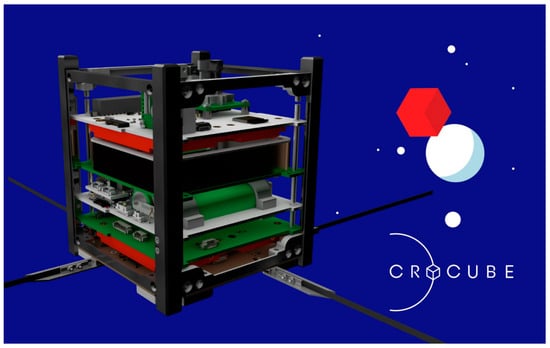
Figure 9.
CroCube satellite (Copyright © 2020 Croinvest.eu) [55].
6. Conclusions
GNSS, RNSS, and SBAS represent the foundation of modern satellite navigation and are key to further technological progress. Although these systems are already advanced and widely deployed, they face new challenges and opportunities. Increasing accuracy, immunity to interference, and integration with other technologies, such as 5G networks, artificial intelligence, and autonomous systems, are the directions of future development. Also, mutual interoperability and standardization of systems will play an important role in the global cohesion of navigation services. Their synergy enables the development of reliable and precise PNT services solutions that will play an even greater role in our daily lives and industrial processes in the future.
Furthermore, the integration of GNSS systems with LEO satellite constellations represents a significant advancement in the development of next-generation PNT solutions. The combination of stronger signal strength, greater spatial and temporal availability, and faster dynamics of LEO satellites enables higher positioning accuracy and improved resilience against interference and spoofing attacks, particularly in challenging urban and indoor environments. Additionally, the implementation of AI-based integrity monitoring systems further enhances the reliability and safety of navigation solutions through automated anomaly detection and real-time error prediction. This technological synergy between GNSS–LEO integration and AI-based approaches forms the foundation for a new generation of robust and scalable PNT systems applicable in critical infrastructure, transportation, and defense sectors.
In conclusion, the overall world situation is changing daily and significantly affects all aspects of the autonomy of individual countries, including events in space. This modernization of GNSS, RNSS, and SBAS enables a significant increase in the number of satellites and innovations in space technology, addressing both military and civilian needs for greater precision in applications such as surveying, transportation, disaster management, agriculture, and urban planning.
Author Contributions
Conceptualization, K.Š. and M.Z.; methodology, K.Š. and M.Z.; validation, K.Š., M.Z., A.T. and K.S.; formal analysis, A.T. and K.S.; investigation, K.Š.; writing—original draft preparation, K.Š.; writing—review and editing, K.Š., M.Z., A.T. and K.S.; visualization, K.Š., A.T. and K.S.; supervision, M.Z.; project administration, K.Š.; funding acquisition, M.Z. All authors have read and agreed to the published version of the manuscript.
Funding
This research was funded by the University of Zagreb under the research project “Automatization of measurement procedure in the Laboratory for Measurements and Measuring Technique of the Faculty of Geodesy”.
Data Availability Statement
No new data were created or analyzed in this study. Data sharing is not applicable to this article.
Conflicts of Interest
The authors declare no conflicts of interest.
References
- Kaplan, E.D.; Hegarty, C. Understanding GPS: Principles and Applications, 2nd ed.; Artech House mobile communications series; Artech House: Boston, MA, USA, 2006; ISBN 978-1-58053-894-7. [Google Scholar]
- Hein, G.W. Status, Perspectives and Trends of Satellite Navigation. Satell. Navig. 2020, 1, 22. [Google Scholar] [CrossRef] [PubMed]
- Langley, R.B. Innovation: GLONASS—Past, Present and Future. Available online: https://www.gpsworld.com/innovation-glonass-past-present-and-future (accessed on 21 August 2025).
- Zrinjski, M.; Bačić, Ž.; Barković, Đ. Modernization of GPS (GNSS-2). Geod. List 2005, 59, 45–61. [Google Scholar]
- Zrinjski, M.; Barković, Đ.; Matika, K. Development and Modernization of GNSS. Geod. List 2019, 73, 45–65. [Google Scholar]
- Hegarty, C.J.; Chatre, E. Evolution of the Global Navigation Satellite System (GNSS). Proc. IEEE 2008, 96, 1902–1917. [Google Scholar] [CrossRef]
- Another Lockheed Martin-Built GPS III Satellite Lifts Off into Orbit. Available online: https://investors.lockheedmartin.com/news-releases/news-release-details/another-lockheed-martin-built-gps-iii-satellite-lifts-orbit (accessed on 12 September 2025).
- Bhattacharjee, N.; Bhattacharjee, N. India Sends Navigation Satellite into Orbit on ISRO Rocket in Landmark Launch. Available online: https://www.reuters.com/technology/space/india-sends-navigation-satellite-into-orbit-isro-rocket-landmark-launch-2025-01-29 (accessed on 12 September 2025).
- Successful Launch of Two New Galileo Satellites-European Commission. Available online: https://defence-industry-space.ec.europa.eu/successful-launch-two-new-galileo-satellites-2024-09-18_en (accessed on 12 September 2025).
- Chen, J.; Zhang, Y.; Yu, C.; Wang, A.; Song, Z.; Zhou, J. Models and Performance of SBAS and PPP of BDS. Satell. Navig. 2022, 3, 4. [Google Scholar] [CrossRef]
- Romaniuc, A.-G.; Vasile, V.-C.; Borda, M.-E. Global Navigation Satellite System Spoofing Attack Detection Using Receiver Independent Exchange Format Data and Long Short-Term Memory Algorithm. Information 2025, 16, 502. [Google Scholar] [CrossRef]
- GNSS Performance Monitoring. Available online: https://gnss-monitoring.dlr.de/ (accessed on 8 September 2025).
- Awange, J.; Kiema, J. Modernization of GNSS. In Environmental Geoinformatics; Environmental Science and Engineering; Springer International Publishing: Cham, Switzerland, 2019; pp. 47–54. ISBN 978-3-030-03016-2. [Google Scholar]
- GPS.Gov: Space Segment. Available online: https://www.gps.gov/space-segment (accessed on 8 September 2025).
- GPS Constellation. Available online: https://www.navcen.uscg.gov/gps-constellation (accessed on 21 August 2025).
- International Committee on Global Navigation Satellite Systems: The Way Forward: 10 Years of Achievement, 2005–2015; United Nations: New York, NY, USA, 2016; ISBN 978-92-1-101333-7.
- U. S. Space Force Field Commands Successfully Launch GPS III. Available online: https://www.ssc.spaceforce.mil/Newsroom/Article/4202300/u-s-space-force-field-commands-successfully-launch-gps-iii-demonstrating-expedi (accessed on 8 September 2025).
- About GLONASS. Available online: https://glonass-iac.ru/en/about_glonass (accessed on 12 September 2025).
- Mooney, J. Soyuz-2.1b Launches Final GLONASS-M Satellite from Plesetsk. Available online: https://www.nasaspaceflight.com/2022/11/kosmos-2564 (accessed on 25 August 2025).
- Galileo, the European Union Global Navigation Satellite System-European Commission. Available online: https://defence-industry-space.ec.europa.eu/document/download/04ae75b0-e6b6-4a12-9e14-ecd9cd6c1a7a_en?filename=Galileo%20the%20EU%20GNSS%20Factsheet.pdf (accessed on 15 September 2025).
- Galileo-EU Agency for the Space Programme. Available online: https://www.euspa.europa.eu/eu-space-programme/galileo (accessed on 21 August 2025).
- Services-European GNSS Service Centre (GSC). Available online: https://www.gsc-europa.eu/galileo/services (accessed on 25 August 2025).
- Galileo Navigation Signals and Frequencies. Available online: https://www.esa.int/Applications/Satellite_navigation/Galileo/Galileo_navigation_signals_and_frequencies (accessed on 25 August 2025).
- CNSS (Compass/BeiDou Navigation Satellite System)-EoPortal. Available online: https://www.eoportal.org/satellite-missions/cnss (accessed on 26 August 2025).
- Yan, Z.; Fraire, J.; Zhao, K.; Yan, H.; Madoery, P.G.; Li, W. Distributed Contact Plan Design for GNSS. IEEE Trans. Aerosp. Electron. Syst. 2019, 56, 660–672. [Google Scholar] [CrossRef]
- QZSS (Quasi-Zenith Satellite System)-Cabinet Office (Japan). Available online: https://qzss.go.jp/en/index.html (accessed on 20 August 2025).
- Quasi-Zenith Satellite Orbit (QZO). Available online: https://qzss.go.jp/en/technical/technology/orbit.html (accessed on 9 September 2025).
- QZSS (Quasi Zenith Satellite System). Available online: https://www.eoportal.org/satellite-missions/qzss#qzss-signals (accessed on 27 August 2025).
- Rao, V. Irnss. In Position, Navigation, and Timing Technologies in the 21st Century; John Wiley & Sons, Ltd.: Hoboken, NJ, USA, 2020; pp. 171–185. ISBN 978-1-119-45844-9. [Google Scholar]
- Indian Space Research Organisation. Available online: https://www.isro.gov.in/index.html (accessed on 20 August 2025).
- Indian Regional Navigation Satellite System: All You Need to Know. Times India 2017, 15.
- Indian Space Research Organisation. Available online: https://www.isro.gov.in/Navigation.html (accessed on 28 August 2025).
- Kim, G.; Park, C.; Lim, D.W. Space Service Volume Augmented with Korean Positioning System at Geosynchronous Orbit. J. Position. Navig. Timing 2020, 9, 327–336. [Google Scholar] [CrossRef]
- Choi, B.-K.; Roh, K.-M.; Ge, H.; Ge, M.; Joo, J.-M.; Heo, M.B. Performance Analysis of the Korean Positioning System Using Observation Simulation. Remote Sens. 2020, 12, 3365. [Google Scholar] [CrossRef]
- SBAS Systems Around the World. Available online: https://www.satnav-africa.com/index.php/en/gnss-and-sbas-at-a-glance/sbas-systems-around-the-world (accessed on 2 September 2025).
- ICAO Annex 10 Aeronautical Telecommunications Vol I. Radio Navigation Aids; International Civil Aviation Organization: Montréal, QC, Canada, 2018.
- Satellite Navigation-Wide Area Augmentation System (WAAS). Available online: https://www.faa.gov/about/office_org/headquarters_offices/ato/service_units/techops/navservices/gnss/waas (accessed on 2 September 2025).
- Kim, J.; Kim, Y.; Kim, J. Technology Trends of Satellite Based Augmentation Systems. J. Position. Navig. Timing 2024, 13, 25–34. [Google Scholar] [CrossRef]
- Revnivykh, I. GLONASS and SDCM Status and Development; ICG-14: Bengaluru, India, 2019. [Google Scholar]
- SDCM Space Segment. Available online: https://gssc.esa.int/navipedia/index.php/SDCM#SDCM_Space_Segment (accessed on 2 September 2025).
- EGNOS-EU Agency for the Space Programme. Available online: https://www.euspa.europa.eu/eu-space-programme/egnos (accessed on 2 September 2025).
- Cheng, L.; Weiguang, G.; Bo, S.; Jun, L.; Wei, W.; Ying, C.; Chengeng, S.; Shuai, X.; Qun, D. Development of BeiDou Satellite-Based Augmentation System. Navigation 2021, 68, 405–417. [Google Scholar] [CrossRef]
- BeiDou Navigation Satellite System. Available online: http://en.beidou.gov.cn (accessed on 3 September 2025).
- MSAS: Air Trafic Control and Airport System. Available online: https://www.nec.com/en/global/solutions/cns-atm/navigation/msas.html (accessed on 4 September 2025).
- Australia, G. Southern Positioning Augmentation Network (SouthPAN). Available online: https://www.ga.gov.au/scientific-topics/positioning-navigation/positioning-australia/about-the-program/southpan (accessed on 4 September 2025).
- ANGA-Association. Available online: https://www.anga-africa.org/en (accessed on 4 September 2025).
- Lee, S.; Han, K.; Won, J.-H. Assessment of Radio Frequency Compatibility for New Radio Navigation Satellite Service Signal Design in the L6-Band. Remote Sens. 2024, 16, 319. [Google Scholar] [CrossRef]
- UK Sovereign Satellite Navigation Overlay Successfully Demonstrated for First Time. Available online: https://www.viasat.com/news/latest-news/government/2024/uk-sovereign-satellite-navigation-overlay-successfully-demonstrated-for-first-time (accessed on 10 September 2025).
- UK & EU Space Programme–Brexit–An Irish Guide. Available online: https://brexitlegal.ie/uk-eu-space-programme (accessed on 10 September 2025).
- McDowell, J.C. The Low Earth Orbit Satellite Population and Impacts of the SpaceX Starlink Constellation. Astrophys. J. Lett. 2020, 892, L36. [Google Scholar] [CrossRef]
- Sesnic, T. Starlink Group 6-31|Falcon 9 Block 5. Available online: https://everydayastronaut.com/starlink-group-6-31-falcon-9-block-5 (accessed on 12 September 2025).
- Grigg, D.; Tingay, S.J.; Sokolowski, M. The Growing Impact of Unintended Starlink Broadband Emission on Radio Astronomy in the SKA-Low Frequency Range. Astron. Astrophys. 2025, 699, A307. [Google Scholar] [CrossRef]
- Petričević, I. GRBBeta. Available online: https://kozmos.hr/grbbeta-najmanji-astrofizicki-svemirski-opservatorij-i-zasto-je-vazan-za-crocube (accessed on 10 September 2025).
- CroCube. Available online: https://crocube.hr (accessed on 10 September 2025).
- Croinvest CroCube: Prva hrvatska kockica u svemiru. Available online: https://croinvest.eu/kampanja/crocube-prva-hrvatska-kockica-u-svemiru/ (accessed on 29 September 2025).
Disclaimer/Publisher’s Note: The statements, opinions and data contained in all publications are solely those of the individual author(s) and contributor(s) and not of MDPI and/or the editor(s). MDPI and/or the editor(s) disclaim responsibility for any injury to people or property resulting from any ideas, methods, instructions or products referred to in the content. |
© 2025 by the authors. Licensee MDPI, Basel, Switzerland. This article is an open access article distributed under the terms and conditions of the Creative Commons Attribution (CC BY) license (https://creativecommons.org/licenses/by/4.0/).
